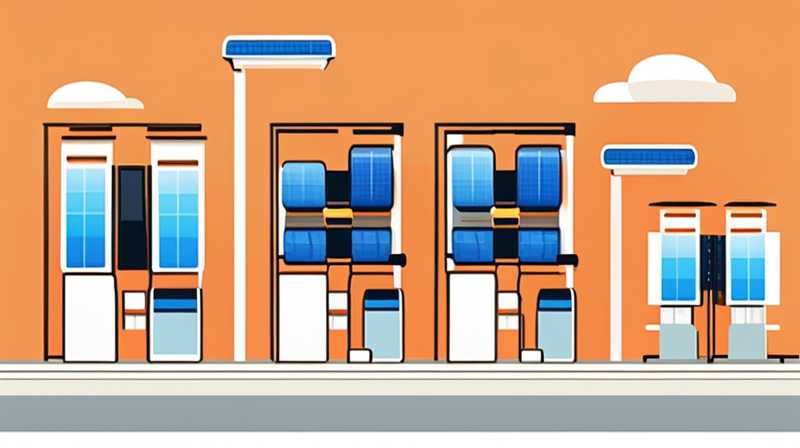
To connect double-layer solar street lights, consider the following essential steps and factors involved in the process: 1. Understand the components, 2. Follow installation guidelines, 3. Ensure proper wiring, 4. Conduct performance tests. Each step is critical for achieving an effective and efficient installation.
- UNDERSTANDING THE COMPONENTS
Initiating any installation involves a clear comprehension of the components. Double-layer solar street lights typically consist of solar panels, LED lights, batteries, controllers, and mounting hardware. Solar panels absorb sunlight during the day, converting it to electrical energy. LED lights provide illumination during nighttime, ensuring visibility and safety. The battery serves as the energy storage unit, powering the lights when solar energy is not available. The controller regulates the charge and discharge of the battery, optimizing its lifespan and performance.
Familiarity with each component’s specifications and features is imperative for a successful connection. The solar panels should match the output requirements of the system, and the LEDs must be selected for desired brightness and energy consumption efficiency. Any mismatch in specifications can lead to diminished performance or even failure of the lighting system.
- INSTALLATION GUIDELINES
Following systematic installation guidelines enhances not only efficacy but also safety. Begin with the site assessment, a crucial preliminary step. The selected location must receive ample sunlight throughout the day, free from obstructions such as trees, buildings, or signage. The height of installation plays a significant role. Ensuring that lights are mounted adequately can provide maximum coverage and reduce glare, thus improving visibility.
Adhering to manufacturer instructions is vital during the actual installation process. These guidelines typically include mounting options (e.g., pole height and angle) and wiring instructions to connect each component effectively. Ensuring all electrical connections are secure and insulated will protect the system from weather-related damage.
- ENSURING PROPER WIRING
Proper wiring is non-negotiable for the seamless operation of double-layer solar street lights. Utilize high-quality wiring resistant to environmental factors such as UV rays, moisture, and extreme temperatures. Attention to wire gauge is crucial for minimizing power loss. Thicker wires are generally preferable as they can handle a larger current without overheating.
During wiring, maintain a clear understanding of the circuitry involved. Connect the solar panel to the controller, followed by the controller to the battery. Finally, wire the LED lights to the battery or an output terminal on the controller, depending on the setup guidelines. Double-checking connections for polarity is crucial, as incorrect wiring can cause short circuits or damage components.
- CONDUCTING PERFORMANCE TESTS
Once installation is complete, conducting performance tests ensures the system operates as intended. Start by checking all connections visually for security and integrity. Observe the solar panels during daylight; they should be functioning correctly, absorbing sunlight efficiently. After sunset, monitor the lighting produced by LEDs. Proper functioning means that lights should illuminate steadily, free from flickering or dimming.
Further, checking the battery performance is essential. It should hold sufficient charge and it is advisable to monitor how long the system runs on a full charge. Such tests provide insights into the functionality of the entire setup and highlight areas requiring fine-tuning or repairs.
FAQs
- HOW LONG DO DOUBLE-LAYER SOLAR STREET LIGHTS LAST?
Double-layer solar street lights can have varying lifespans based on components and usage. Typically, solar panels can last 25-30 years if maintained well. The LED lights generally last about 50,000 hours, while batteries may require replacement every 3-5 years depending on usage and environmental conditions. Regular maintenance plays a crucial role in extending these averages. To ensure longevity, it’s imperative to monitor and replace worn-out parts promptly. Additionally, different manufacturers may offer warranties, affecting lifespan reliability.
- WHAT ARE THE BENEFITS OF USING SOLAR STREET LIGHTS?
Opting for solar street lights offers numerous advantages. Sustainability is at the forefront; these lights harness renewable solar energy, reducing dependency on traditional power sources and minimizing the carbon footprint. Furthermore, they can be installed in remote or off-grid locations where conventional electricity access is limited or nonexistent. Cost-effectiveness comes into play as well, since they entail lower operational and maintenance costs over time. Notably, these lights often come equipped with advanced features, like motion sensors and dimming options, enhancing efficiency and user experience without compromising functionality.
- HOW DO I MAINTAIN DOUBLE-LAYER SOLAR STREET LIGHTS?
Maintenance of double-layer solar street lights involves periodic inspections, cleaning, and component replacements. Regularly examine solar panels for dirt, debris, or foliage that may block sunlight. Cleaning once or twice a year ensures optimal energy absorption. Additionally, conduct checks on the wiring for integrity and secure connections. Inspect LEDs for any signs of dimming or malfunction, which may indicate the need for replacement. Batteries require particular attention, as they may need replacement every few years; monitoring their performance helps prevent unexpected failures. Keeping records of maintenance actions can further enhance the longevity and performance of the lighting system.
Connecting double-layer solar street lights requires careful planning, understanding, and execution. Each stage, from comprehending components to ensuring proper wiring and performance checks, plays a vital role in achieving effective illumination. By following structured guidelines and adhering to maintenance protocols, one can ensure a reliable and sustainable street lighting solution. The advantages of solar street lights over conventional systems, including cost savings and environmental friendliness, further validate their adoption. Entrusting this endeavor to professionals or conducting thorough research increases the likelihood of achieving a successful setup. In the long run, double-layer solar street lights not only provide illumination but also serve as a beacon of innovation and sustainability in modern urban planning.
Original article by NenPower, If reposted, please credit the source: https://nenpower.com/blog/how-to-connect-double-layer-solar-street-lights/


